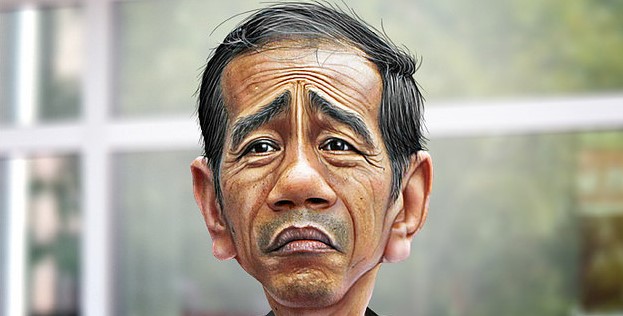Indonesia’s Global Maritime Axis Askew

President Joko Widodo’s Global Maritime Axis (GMA) vision and its five pillars gave hope to Indonesians that the country is finally returning to its roots and identity. After almost two years, however, what is the vision actually delivering?
On 13 November 2014 during the 9th East Asia Summit (EAS) in Naypyitaw, Myanmar, President Widodo declared Indonesia a Global Maritime Axis (GMA) with its five key areas of development known as “pillars”. These are: maritime culture, maritime economy and resources, maritime infrastructure and connectivity, maritime diplomacy and maritime security. The announcement sent waves of excitement and hope to not only Indonesians who believed in the motto of Jalesveva Jayamahe (“it is at sea we shall prevail”) but also to the region. However, so far these hopes have not been fulfilled.
The GMA hype
Immediately Indonesia was overwhelmed by the Global Maritime Axis. Seminars, symposiums, workshops and discussion forums were organised by government institutions, universities and academics as well as non-governmental organisations (NGOs). Everyone was keen to talk about how to contribute. In short, there was a maritime euphoria in the country.
Ever since the implementation of this policy, the Widodo government has been committed to improving Indonesian islands’ connectivity. This is particularly true in the Eastern part of Indonesia where 33 port projects out of the 35 are located. During his speech before the participants of the Marine Environment Protection Committee Forum (MEPCF) in the Headquarters of the International Maritime Organization (IMO) in London on 19 April 2016, President Widodo underlined the importance of this project.
Conflicting visions
While initial steps such as these are positive and on point, the implementation of the rest of the pillars, for example maritime security, reflects a different nuance and includes conflicting visions. These conflicting interests include the air force’s amphibious aircraft aspiration, the national police’s desire to have unlimited authority at sea and the possibility of having large vessels patrol the Exclusive Economic Zone (EEZ). It seems that the 1982 United Nations Convention on the Law of the Sea (UNCLOS) does not even enter into consideration. Such inconsistencies in interpretation of the maritime policy are highly detrimental.
How could such a grand vision be interpreted in so many different ways by so many different agencies? The answer is quite obvious: the lack of guidance on what should be done to realise the concept of Global Maritime Axis. There are even differences in terms of its definition. Is it a vision, a strategy or a policy? Ask this question to different people from different institutions and you may very well receive different answers. In 2015 for instance, a government agency proposed pushing Global Maritime Axis to become Indonesia’s grand strategy through a series of workshops and seminars. The idea did not resurface until recently.
The Natuna incident
In March 2016, a Chinese Coast Guard vessel rammed itself to release a Chinese fishing vessel that was towed by Indonesia’s maritime force. This is a useful example of how different interpretations of the fourth and fifth pillars – maritime diplomacy and maritime security – influenced Indonesia’s mixed reaction. Related ministries applied different approaches to the incident due to differing interpretations on the country’s foreign policy. The issue became even more interesting when the Cabinet Secretary announced that Indonesia and China agreed that the Natuna incident was only a case of misunderstanding and both considered the case closed after President Jokowi met with senior delegates of the Chinese Communist Party (CCP).
Late last month, Coordinating Minister for Political, Legal and Security Affairs Luhut Pandjaitan told the media that his three-day visit to China focused on cooperation in the fishery sector and reiterated the commitment by both countries to not go public, in case an incident such as Natuna ever happened again. This is contrary to Indonesia’s previous position of not acknowledging China’s claim of traditional fishing ground in the Natuna waters.
Implementation of the five pillars
Clearly something is missing in Indonesia’s maritime diplomacy and security, two of the maritime policy pillars. There is a distinct lack of clear direction on how to implement the five pillars. Ideally such guidance should be formulated by the office of the Coordinating Minister for Maritime Affairs, however around a year and a half after President Jokowi’s announcement of Global Maritime Axis, this has yet to happen. This has allowed related agencies to formulate their own interpretations and understanding.
The Natuna incident demonstrates the lack of coordination and unity of action within the administration. This is a consequence of not only unclear foreign policy but also the need to have a formal document providing guidance on the types of action needed to realise its Global Maritime Axis. Although it may be two years too late to make such a document, it is better than nothing at all. Now, the next step is to ensure that it is implemented effectively and consistently.
Janet Dyah Ekawati is Co-founder and Senior Consultant at Srikandi Adhirajasa Nayyotama (SAN), a consulting group on military language and defence issues. She has worked for the Indonesian military, particularly in the Indonesian Navy, for 10 years as an interpreter and a writer. She is also a special staff to Admiral Dr Marsetio (Ret.), senior advisor to the Coordinating Minister for Maritime Affairs as well as Indonesia’s Special Envoy to IMO. The opinions expressed here are personal and do not reflect the views of the institutions or individuals she works for. This article can be republished with attribution under a Creative Commons Licence.




